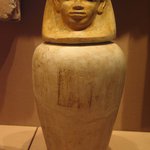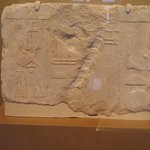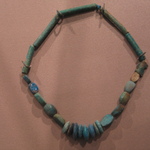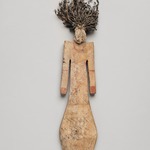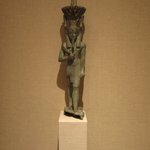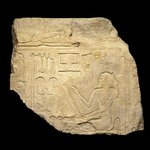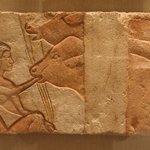

Senwosret I, ca. 1919–1875 B.C.E. Limestone, pigment, 6 9/16 x 19 11/16 in. (16.7 x 50 cm). Brooklyn Museum, Charles Edwin Wilbour Fund, 52.130.1. Creative Commons-BY (Photo: Brooklyn Museum, CUR.52.130.1_erg2.jpg)
Senwosret I
Egyptian, Classical, Ancient Near Eastern Art
On View: Old Kingdom to 18th Dynasty, Egyptian Galleries, 3rd Floor
Most Egyptian reliefs decorating ancient temple walls were brightly painted. Limestone was too porous to allow for an even application of color, so artists usually covered a wall with plaster, smoothed the surface, and painted directly on the dried plaster. Over time, the painted plaster layer separated from the limestone and fell from the wall, so very little original coloration survives. Through the accidents of preservation, this fragment of the king’s face retains most of its ancient paint.
MEDIUM
Limestone, pigment
DATES
ca. 1919–1875 B.C.E.
DYNASTY
Dynasty 12
PERIOD
Middle Kingdom
DIMENSIONS
6 9/16 x 19 11/16 in. (16.7 x 50 cm) (show scale)



COLLECTIONS
Egyptian, Classical, Ancient Near Eastern Art
ACCESSION NUMBER
52.130.1
CREDIT LINE
Charles Edwin Wilbour Fund
CATALOGUE DESCRIPTION
Fragment of limestone temple relief. At left, upper half of face of king wearing Upper Egyptian crown. At extreme right, portion of two strands of flail (?). Colors well preserved; skin of king red; eye-strips and eyebrows, blue; crown yellow (?); background, white.
Condition: Preserved portion intact. Slight loss of paint.
EXHIBITIONS
MUSEUM LOCATION
This item is on view in Old Kingdom to 18th Dynasty, Egyptian Galleries, 3rd Floor
CAPTION
Senwosret I, ca. 1919–1875 B.C.E. Limestone, pigment, 6 9/16 x 19 11/16 in. (16.7 x 50 cm). Brooklyn Museum, Charles Edwin Wilbour Fund, 52.130.1. Creative Commons-BY (Photo: Brooklyn Museum, CUR.52.130.1_erg2.jpg)
IMAGE
overall, CUR.52.130.1_erg2.jpg. Brooklyn Museum photograph, 11/26/2007
"CUR" at the beginning of an image file name means that the image was created by a curatorial staff member. These study images may be digital point-and-shoot photographs, when we don\'t yet have high-quality studio photography, or they may be scans of older negatives, slides, or photographic prints, providing historical documentation of the object.
RIGHTS STATEMENT
Creative Commons-BY
You may download and use Brooklyn Museum images of this three-dimensional work in accordance with a Creative Commons license. Fair use, as understood under the United States Copyright Act, may also apply.
Please include caption information from this page and credit the Brooklyn Museum. If you need a high resolution file, please fill out our online application form (charges apply).
For further information about copyright, we recommend resources at the United States Library of Congress, Cornell University, Copyright and Cultural Institutions: Guidelines for U.S. Libraries, Archives, and Museums, and Copyright Watch.
For more information about the Museum's rights project, including how rights types are assigned, please see our blog posts on copyright.
If you have any information regarding this work and rights to it, please contact copyright@brooklynmuseum.org.
RECORD COMPLETENESS
Not every record you will find here is complete. More information is available for some works than for others, and some entries have been updated more recently. Records are frequently reviewed and revised, and we welcome any additional information you might have.












